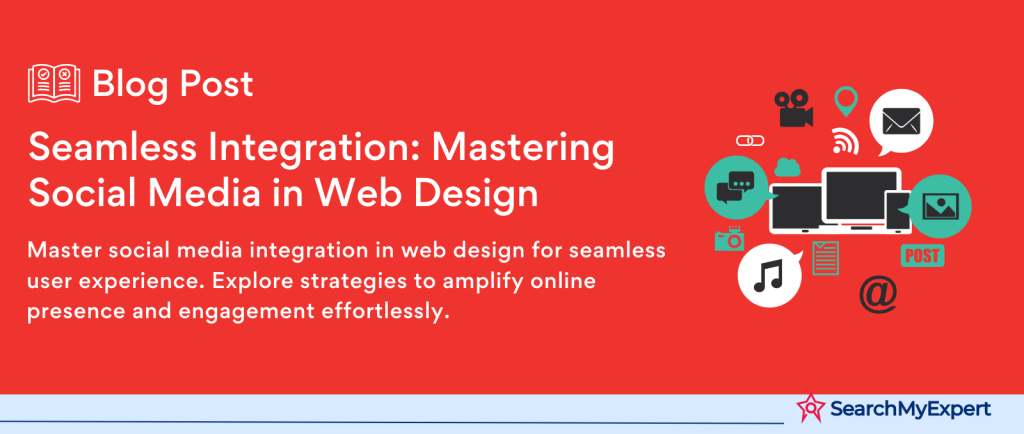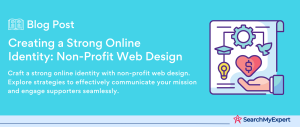Social Media Integration in Web Design
The Essence of Social Media Integration in Web Design
In the whirlwind of the digital era, social media integration stands as a pivotal component of web design. This concept refers to the strategic embedding of social media elements into a website’s architecture. It’s akin to weaving a digital tapestry where social media threads intertwine with the fabric of the website, creating a seamless and interactive user experience.
The Benefits: A Double-Edged Sword
Integrating social media in web design brings a cornucopia of benefits:
- Enhanced User Engagement:
Social media buttons, feeds, and sharing options make websites more interactive and engaging. - Increased Traffic and Visibility:
Social shares amplify the reach of your content, driving more traffic to your site. - Improved Brand Awareness and Loyalty: Regular interaction on social media fosters a sense of community and loyalty among users.
- SEO Boosts:
Social signals can indirectly enhance your website’s search engine rankings. - Real-Time Feedback and Analytics:
Social media provides instant feedback and valuable data about user preferences and behaviors.
However, it’s not all sunshine and rainbows. Potential drawbacks include:
- Overwhelm and Clutter: Excessive social media elements can clutter your website, detracting from its core message.
- Privacy Concerns: Integrating social media can raise data privacy and security issues.
- Brand Image Risks: Unmoderated social content might harm your brand’s image.
- Dependence on External Platforms:
Changes in social media platforms can impact your website’s functionality.
The Integration Journey: Key Steps
The process of integrating social media into web design involves several key steps:
- Assessment and Strategy Development: Understanding your website’s purpose and how social media can enhance it.
- Choosing the Right Platforms: Selecting social media platforms that align with your audience and brand identity.
- Design and Implementation:
Seamlessly incorporating social media elements into the website’s design. - Monitoring and Optimization: Continuously analyzing the performance and optimizing the integration for better results.
Defining Your Goals for Social Media Integration
Identifying Your Target Audience
- Demographic Analysis: Understanding the age, gender, location, and interests of your audience shapes the strategy.
- Platform Preferences: Different demographics favor different social media platforms. Identifying these preferences is key.
Determining Specific Goals
- Increased Engagement:
Aiming to boost interactions, comments, and shares. - Brand Awareness: Expanding the reach of the brand to a broader audience.
- Lead Generation: Using social media to attract potential customers.
- Customer Service:
Providing support and interaction through social media.
Setting Measurable Objectives
- Engagement Metrics: Track likes, shares, and comments to measure engagement.
- Traffic Analysis: Monitoring the amount of traffic directed from social media to the website.
- Conversion Rates:
Measuring the rate at which social media interactions lead to desired actions (e.g., sales, sign-ups). - Feedback and Surveys: Gathering user feedback to assess satisfaction and areas for improvement.
Choosing Your Platforms for Social Media Integration
Analyzing Your Target Audience
The foundation of effective social media integration lies in knowing your audience:
- Demographic Insights: Age, location, interests, and lifestyle play a crucial role in determining platform preference.
- Behavioral Patterns: How does your audience interact online? Do they prefer visual content on Instagram or professional interactions on LinkedIn?
- Engagement Trends: Analyzing where your audience engages most helps in choosing the right platform.
Aligning with Brand Voice and Content Strategy
- Brand Identity Consistency: Choose platforms that resonate with your brand’s tone, whether it’s professional, playful, or creative.
- Content Suitability: Some platforms are better for video, others for images or text. Match your content strategy with the platform’s strengths.
Focusing on Key Platforms
- Quality Over Quantity:
It’s more effective to have a strong presence on a few platforms than a weak presence on many. - Resource Allocation:
Consider the time and resources needed to maintain a quality presence on each platform.
Selecting Integration Strategies
Exploring Integration Options
Choosing the right strategies can enhance user experience and meet your objectives:
- Social Sharing Buttons:
Simple yet effective, they encourage users to share content directly from your website. - Live Social Feeds:
Display real-time updates from your social media accounts, keeping content fresh and dynamic. - User-Generated Content (UGC) Galleries:
Showcase customer photos and stories, building trust and community. - Social Media Logins:
Simplify the login process by allowing users to sign in with their social media accounts. - Social Media Walls:
Aggregate posts from various platforms into a single, interactive display.
Tailoring Strategies to Your Goals
- Goal Alignment:
Each strategy should align with specific objectives like increasing engagement or driving traffic. - Visitor Value:
Choose strategies that add value to your visitors’ experience, making your website more engaging and useful.
Implementing Integration Features
Harnessing Social Media Plugins and Tools
- Choosing the Right Tools: Select plugins and tools that offer the features you need, such as social sharing buttons or live feeds.
- Customization for Fit:
Customize these tools to align with your website’s design and functionality.
User-Friendly Experience Across Devices
- Responsive Design: Ensure that social media features are fully functional and visually appealing on both desktop and mobile platforms.
- Loading Speed:
Optimized integration tools should not slow down your website.
Consistent Brand Aesthetic
- Visual Harmony:
Align the design of social media elements with your website’s overall aesthetic. - Unified Messaging: Ensure that the content across platforms maintains a consistent brand voice and message.
Content Strategy and Promotion
Creating Engaging Social Content
- Content That Resonates:
Develop content that aligns with your audience’s interests and encourages interaction. - Visual Appeal:
Use attractive images, videos, and infographics to grab attention. - Share-Worthy Posts: Craft content that users are compelled to share, like insightful articles or entertaining videos.
Utilizing Social Sharing Features
- Easy-to-Use Buttons: Incorporate social sharing buttons in strategic locations on your site.
- Prompting Shares: Use calls-to-action to encourage users to share content.
Promoting Your Social Presence
- Website Integration:
Prominently display social media icons on your website. - Cross-Channel Marketing: Use email newsletters, blogs, and other marketing channels to promote your social media pages.
Tracking and Analysis of Social Media Integration
Monitoring Key Metrics for Effectiveness
- Understanding Key Metrics: Key metrics include user engagement (likes, shares, comments), website traffic from social media, and conversion rates.
- Tools for Tracking: Utilize analytics tools like Google Analytics and social media-specific dashboards to gather data.
Analyzing User Engagement and Traffic
- User Engagement Insights:
High engagement rates often indicate content resonance and effective social media integration. - Traffic Source Analysis:
Identifying which social media platforms drive the most traffic helps focus efforts on the most fruitful channels. - Conversion Tracking: Assess how social media interactions lead to desired actions, like sales or sign-ups.
The Power of Data in Adaptation
- Data-Driven Strategy: Analyzing data allows for a more targeted and effective social media strategy.
- Continuous Improvement: Regular analysis helps in continually refining and improving social media integration.
Understanding the Audience Through Analytics
- Demographic Insights: Analytics provide valuable information about the audience, such as age, location, and interests.
- Behavior Patterns:
Understanding how users interact with your social media and website can inform content and design decisions.
The Role of A/B Testing
- Experimentation for Optimization:
A/B testing different elements (like button placement or content types) can reveal what works best. - Iterative Process:
Continuously test, analyze, and adapt based on results for ongoing improvement.
Leveraging Analytics for Content Strategy
- Content Performance Analysis:
Determine which types of content perform best and why. - Strategic Content Planning:
Use insights to plan future content that aligns with audience preferences and behaviors.
Integrating Feedback Loops
- User Feedback Integration: Incorporate user feedback for a more user-centric approach.
- Responsive Adjustments: Quickly adapt to feedback and trends to keep your social media integration relevant and effective.
Challenges in Tracking and Analysis
- Data Overload:
Avoid getting overwhelmed by focusing on key metrics that align with your goals. - Keeping Up with Changes: Social media is ever-evolving, so staying informed about platform changes is crucial.
Long-Term Success Through Analytics
- Goal Alignment:
Ensure that your social media efforts align with your long-term business goals. - Sustainable Strategies:
Develop strategies that are sustainable and adaptable over time.
Conclusion
In the digital era, the integration of social media into web design is not just a trend; it’s a strategic necessity. This comprehensive guide has walked you through the essential steps to effectively merge social media with your website. From understanding your audience and selecting the right platforms, to implementing user-friendly features, and continuously optimizing your strategy based on data-driven insights, each step is crucial in creating a cohesive and engaging online presence.
Social media integration is an art that balances technical savvy with creative flair. It’s about crafting a seamless experience where your website and social media platforms complement and enhance each other, fostering deeper connections with your audience. By embracing these principles, you position your brand to thrive in a connected world, where the boundaries between websites and social media are increasingly blurred.
As we’ve explored, the journey doesn’t end with implementation. The digital landscape is dynamic, and so must be your approach. Regular analysis, adaptation, and innovation are key to staying relevant and resonant with your audience. Remember, the goal is not just to direct traffic between your website and social media but to create a synergistic relationship that amplifies your brand’s voice and extends its reach.
Embrace the challenge, and let the fusion of web design and social media open new horizons for your brand. The possibilities are endless, and the rewards are substantial for those who navigate this terrain with skill, strategy, and an eye towards the future.
Reimagine your digital world with our Web Design Services.
Table of Contents
Toggle






